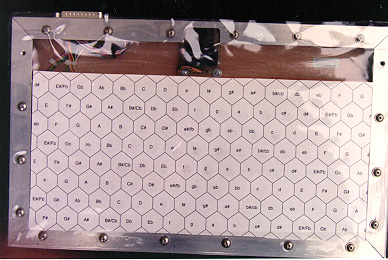 The Clavette generalized microtonal MIDI keyboard controller was
designed by Harold Fortuin in 1994, and the first instrument was built by Bert Bongers and Theo Borsboom at the Institute of Sonology in The Hague, Netherlands, with support from STEIM in Amsterdam.
(This instrument currently resides at the Institute.) The second instrument's keyboard was built again by Bongers, but other
re-engineering was done in and around Minneapolis from 1995-96: the pedals were re-engineered by Dennis
Cordell, with wiring and other additional technical work by Darrell Klotzbach and Steve Zehm.
The Clavette generalized microtonal MIDI keyboard controller was
designed by Harold Fortuin in 1994, and the first instrument was built by Bert Bongers and Theo Borsboom at the Institute of Sonology in The Hague, Netherlands, with support from STEIM in Amsterdam.
(This instrument currently resides at the Institute.) The second instrument's keyboard was built again by Bongers, but other
re-engineering was done in and around Minneapolis from 1995-96: the pedals were re-engineered by Dennis
Cordell, with wiring and other additional technical work by Darrell Klotzbach and Steve Zehm.The keys are momentary switches arranged in a hexagonal pattern on a board 8 1/2 by 14 inches. The 8 rows contain alternately 16 or 15 keys each, and are about 0.8 inches apart. This arrangement works well for a variety of tunings, without being biased toward any particular one. Paper pitch templates slide into a transparent plastic envelope above the keys as a performance aid. The envelope also makes it easy to play two or three keys at once with one finger, and also enables the execution of key glissandos in a variety of shapes and directions.
The right and left foot pedals usually control volume for each hand, but can be programmed to control almost any sound parameter.
The foot switches are used for a variety of switching functions.
A 30 minute video documentary about the instrument is available for broadcast or purchase.
The Clavette accompanies Kris Peck's Asta, a 20-tone just intonation electric guitar, in Fortuin's Endangered Species. See the Quicktime video excerpt in high (5.5 MB), medium (2.2 MB), or low (800KB) quality.